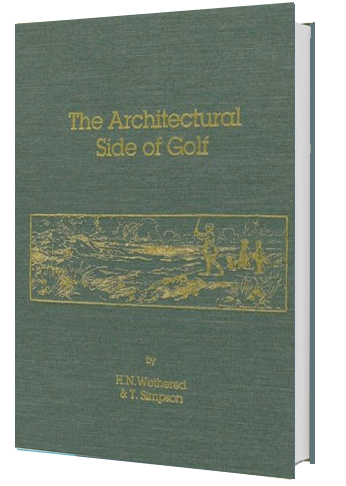Architectural Side of Golf, The (1929) IRIS
$50.00
$50.00Add to cart
By H.N. Wethered and T. Simpson
The Architectural Side of Golf, written at the close of the golden era of golf architecture, is the discipline’s grandest literary gem. It is the last and most lavish of the several books on design published during the 1920s, with 44 plates drawn by Simpson and 26 etchings by Wethered. The authors reaped the benefit of seeing prior publications and crafted this to be as little like a textbook as possible, while exploring a wide variety of subjects directly and indirectly related to architecture. Excepting Sutton’s 1933Golf Courses: Design, Construction and Upkeep, this would be the last book published on golf course architecture for decades. Familiar to designers, The Architectural Side of Golf should also be in the hands of amateurs and committee persons who tinker with re-design or contemplate alteration of their home courses.
The authors surmise the golf course is at a crossroads. In the 1920s, they say, gone are the carefree days of yore when the players were “a mere handful of local enthusiasts who did not, perhaps, take the game in quite as serious a spirit as is the present custom.” The modern ball and clubs produce better, longer shots of controlled shapes in the hands of the pros. Match play has given way to stroke play and thus increased attention to every strike. This is modern golf, attacking all the time, shooting for the pin. The best players now practice regularly—even putting—and thereby invent all manners of shots to escape trouble. The authors ponder how an architect can defend the onslaught against par. In the beginning of the 21st century, we frequently hear critics argue, “today’s golf ball goes too far.” Distance was as hot a topic in the Roaring Twenties as it is now. How accurate Simpson and Wethered were in their prediction about balls: “In all probability there is still room for an additional length quite sufficient to upset present calculations.” Another concern for architects of that era—and this—is the degree to which wedge play had been perfected.
The design solutions for today are as then. In the search to frustrate the constantly dropping scores, success is not to be found in lengthening the holes—the ball will keep going further. Rather, allow semi-rough come into play more, make primary rough penal; reduce the size of the greens and remove backdrops that provide clues to distance; let every bunker and hazard be strategic. Finally, keep everything in proportion caution the authors. Remember that only one percent of golfers are “cracks” and the average guys are the ones who really keep the club afloat. Wethered and Simpson challenge all designers not to fail in any of the obvious points for building courses: every hole should be interesting; the maximum variety of holes allowed by the site should be provided; the natural beauty of the country should be impaired as little as possible; a premium should be put on good golf; and the course should be equally interesting and amusing to the first-rate and the second-rate golfer. The discipline needed to abide by these hard and fast rules is more than many architects have been able to muster.
One of the outstanding features of this book is the use of hole and feature drawings to illustrate the text, many from courses unvisited by even the most ardent seekers, like Chantilly, Liphook, Waddesdon, Chiberta-Biarritz, and Morfontaine. The effect of this feature is most evident in the authors’ interesting discussion about the ideal golf course. Before presenting their favorite 18, and they are all winners, Wethered and Simpson firmly denounce any attempt to actually build such a composition course. Suppose, they say, every hole was of a strength and character of the 17th at St. Andrews Old: “The strain of it all!…It would certainly break our hearts and leave us nervous wrecks or golf lunatics in real earnest.” We can all join in this pleasant theoretical exercise. This is an especially nice book if you like St. Andrews. Different chapters cover the South of England, Northern Scotland, and East Lothian, but the authors clearly are enamored with the Old Course. Many of the references throughout the text relate to the venerable links, especially so in the unique section entitled The Reversible Golf Course. There is camaraderie amid history and philosophy, notably in the chapterCaddies We have Met. One particular caddie had “the appearance of a bird of prey, with hooked nose and fierce bright eyes glimmering at one, and a look that was commanding yet inscrutable…carried the clubs under his arm in the old manner, as if prepared to charge the enemy with the bayonet at the least provocation.” Having been treated with diplomatic firmness throughout the round, the author felt it “expedient to dribble a small stream of silver into his palm until there were signs of a sufficiency to appease his humour.” Equally imaginative—and surprisingly prescient on the topic of architecture—is a chapter on home golf,In an English Garden.
The often subtle but pervasive philosophy in The Architectural Side of Golf is as important and sound as the technical advice. The new culture of golf began in a whirl when vastly more people began to play, equipment improved dramatically and courses were routinely constructed inland. Whatever it was before, golf became a blend, an amalgamation of art and science. More than anything, it became paramount that the architect be alert to their proper balance. Science can overpower the artistry of man imitating nature, just as seeking perfection in artistry can confound science. Given the fluid nature of golf and its components, it is a testimony to the value of this work that its subjects remain germane in any given greens committee meeting today.
Foreword by Herbert Warren Wind.
Additional information
| Weight | 3 lbs |
|---|

